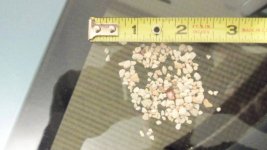Snook
Still Learning
i think i'm safe as long as i feed them.
good news on the stent procedure! my duct is holding up fine. went for a long bike ride this morning. life is good.
i like the net pot idea for small plants. but what are you going to use for a tailpiece? the regular one is way bigger than you need but will probably work fine. we need to find something 1/2" or so. maybe 3/4.
bow wow!
in a 2x4 space you just don't have much room for vertical. IF is doing a one plant scrog with two 600's horizontal and the growth is ferocious. a good way to max a tight space.
you know it's all about veg time and when to flip. less veg time more plants. more veg time less plants.
hey, can you put up a photo of the napa stuff next to a ruler? close up if possible?
later
I havent found (touched) any type of turface but here is the pic of the 8822.






 FWIW, I think you nailed everything except for an insignificant detail of where the rez air goes once more water fills it.
FWIW, I think you nailed everything except for an insignificant detail of where the rez air goes once more water fills it. 


